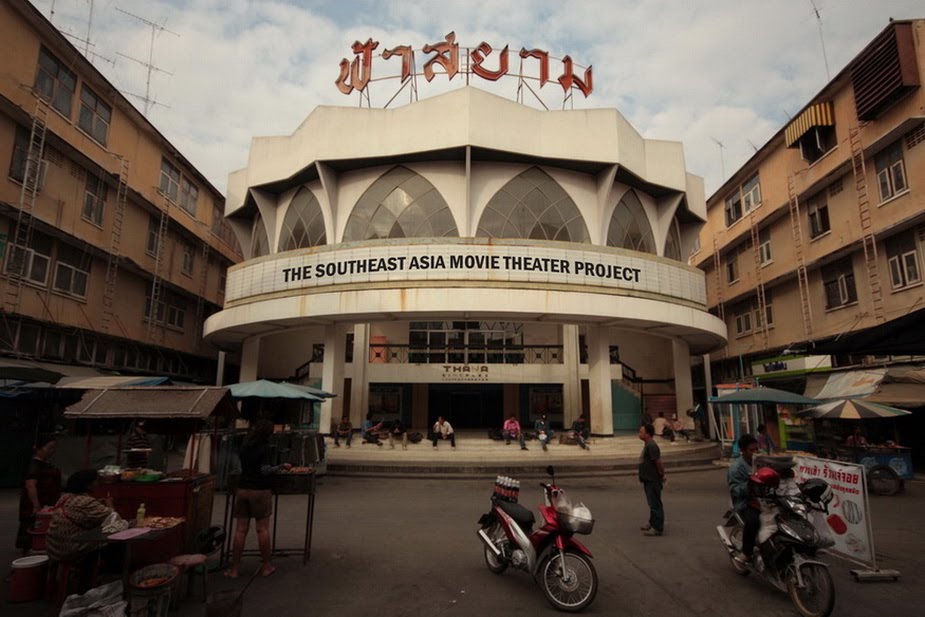But that's not the point. The point is that timing is everything. When presented with knowledge of an active stand-alone movie theater in the twilight of its existence one should not procrastinate. Chances are that that golden opportunity will slip away. It certainly did in this case.
Word of the Charoenpon Rama first reached me about 6 years ago. Back then it was an active double feature theater in the workaday Bangkok suburb of Pathumthani. There were roughly 10 such theaters in and around Bangkok when this project commenced. A fact which I suppose I took for granted. By the end of 2013 none of them were left, including the Charoenpon Rama, which, although on my radar since 2009, I had neglected to document while operational. The multi-legged bus journey necessary to reach it from central Bangkok always put me off.
In mid-2012 I was informed the theater had closed.
The Charoenpon Rama - the last operating stand-alone on Pathumthani Province, now closed.
So, in October 2015, with prior knowledge of its defunct state of existence, I braved the confounding bus routes to see what there was to see.
The Charoenpon Rama is, or was, the anchor business of Pathumthani's main wet market and bus depot. A soot stained, grime coated kind of place rife with mangy strays and foul smells. At least half of the market stalls were unused, an occupancy rate about on par with the shop-houses encircling the market. Might the theater's closing have had a ripple effect of the overall economy of the quarter?
Inquiries among vendors as to the owner of the theater led me to a nearby internet cafe. I opened the door and was greeted with the co-mingled aroma of BO and flat soda. The shop's young proprietor - owner of the BO - was kind enough to peel himself off his ragged pleather recliner and his on-line strategy game to call his landlord on my behalf. Same owner as the Charoenpon Rama, the landlord. The theater owner picked up, but the conversation went nowhere. He was perfectly disinclined to leave the comforts of his home - apparently just around the corner - so that some sweaty photographer could take pictures inside his forlorn family business.
"Just shoot it from the outside," he advised smugly over the phone.
That is unfortunately all that I was able to accomplish on that hot and sticky day. A few half-decent exterior shots of the Charoenpon Rama. While the structure itself is rather standard for a 1970's Thai stand-alone, the dimensional rooftop signage is extraordinary. That font maybe the most dynamic I've ever seen anywhere. It's almost cartoonish in its overwrought extremism. Whoever designed it had a vivid imagination.
Exquisite signage on the Charoenpon Rama. The light sconces at the top of the International Style pilasters are also a nice touch.
Amazing signage aside, the highlight of this entire failed excursion was, of all things, the bus ride up and back. That same bus ride that had turned me off to the trip in the first place. On the bus to Pathumthani, the fare collector struck up a conversation as to the freakishly non-touristic route that this Thai speaking foreigner had embarked upon. When he learned that my journey was in the name of movie theater documentation he scratched his head, but then became quite enthusiastic. As it turned out, he had grown up in the Nang Loeng quarter of Bangkok where he regularly attended films at the neighborhood's eponymous theater. Stricken with nostalgia, the overjoyed fare collector ranted on and on about the Nang Loeng Theater, recounting stories of his teenage years, sneaking in, smoking cigs, hanging with his homies in the ancient wooden movie hall.
When the bus reached the last stop, he bade me farewell before pointing me in the direction of the Charoenpon Rama, where the above anti-story unfolded.
Timing being what it is, however, on the return trip, about two hours later, I boarded the same bus with the same fare collector. This time excited by the idea that I had fulfilled my documentary duty, he refused to charge me for the ride. "No, no, no," he insisted. "I like what you're doing. This ride is on me."
Ten minutes into the return journey, bantering back and forth with the jovial fare collector as he collected fares, the bus company supervisor boarded to inspect tickets. I shot my fare collector friend a nervous glance, worried that my lack of a ticket would get him in trouble. He winked, indicating not to fret. Keep cool, my man! Stay calm!
The supervisor made his way from passenger to passenger inspecting their tickets, getting closer with each step. When he was just one passenger away from reaching free-ride me, the nostalgic and ever-so-sly fare collector slid between us, stealthily placing a fresh ticket in the palm of my hand.
Funny how chance and timing work.

























